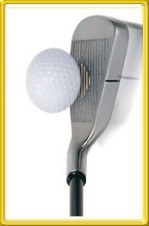
In golf, the term “Coefficient of Restitution” (COR), also known as the “spring-like effect,” refers to a measurement that indicates the elasticity or “bounciness” of a golf ball when it collides with a clubface. It is a standardized measurement that quantifies the ball's ability to transfer energy back to the ball upon impact.
Here are a few key points about the Coefficient of Restitution (COR) in golf:
- Measurement: The COR is measured using a testing apparatus that records the ball's initial speed and the speed after impact with a clubface. The COR is calculated as the ratio of the final velocity to the initial velocity of the ball.
- Limits and Regulations: Golf's governing bodies, such as the United States Golf Association (USGA) and the R&A, set limits on the maximum COR value allowed for golf balls used in competition. These limits ensure fair play and maintain a balance between technology and skill in the game. Currently, the USGA limit for COR is 0.830, meaning the ball cannot exceed a restitution of 83% of its initial velocity after impact.
- Effect on Distance: The COR of a golf ball directly affects its energy transfer and, consequently, its distance potential. A higher COR value indicates that the ball is more efficient in transferring energy back to the ball upon impact, resulting in greater ball speed and longer distance. However, it's important to note that other factors such as launch conditions, spin rates, and strike quality also influence distance.
- Clubface Influence: The clubface's design and construction also play a role in the COR effect. The trampoline-like effect is more pronounced with clubfaces that have thinner, more flexible materials or structures, allowing for higher COR values. However, clubface designs must adhere to regulations set by golf's governing bodies to maintain fair play.
- Equipment Considerations: The COR value of a golf ball is an important consideration for golfers when choosing equipment. Different golf balls may have varying COR values, and selecting a ball with a specific COR can help golfers optimize their distance, feel, and overall performance based on their swing characteristics and preferences.
Understanding the Coefficient of Restitution (COR) can help golfers make informed decisions about their golf ball selection, clubface technology, and overall equipment choices. It is important to note that the COR is just one of several factors, including swing mechanics, ball spin, and launch conditions, that contribute to overall performance on the golf course.
Coefficient of Restitution (COR) for Golf Balls: A measurement of how much a ball will rebound off a clubface. The formula for determining golf ball COR is Ball Speed Off the Clubface divided by Clubhead Speed at Impact.






